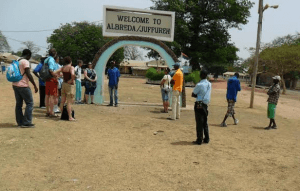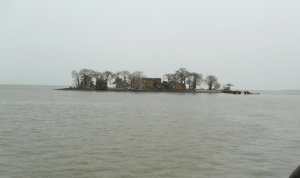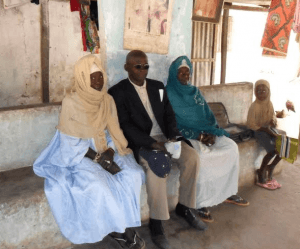Visit to the slave island of The Gambia

In July 2014, my family friend in The Gambia invited me to visit the country affectionately called the Smiling Coast, located in the upper limit of the Gulf of Guinea.
Before I embarked on my visit, I shared this information with an American friend from Boston who lives in Cape Cod, USA. He suggested that once in The Gambia I should take the opportunity to visit the “Slave village” of Kunta Kinte.
We started off in Banjul around 9:30am on a tourist boat which sailed for about two and half hours to the north central part of the River Gambia, where the Kunta Kinte village is located.
Before we sighted the Dog Island, most of the passengers in the boat had spotted dolphins which were swimming very close to our boat. Most passengers were extremely excited when they sighted the dolphins.
The Portuguese were the first Europeans to settle on the Dog Island around 1456. They abandoned the island because of its frequent incidences of low tide.
At low tide, the natives were able to wade through that section of River Gambia, to Dog Island. The Portuguese therefore found it unsafe and therefore abandoned it for a group of Germans.
The unique thing about Dog Island is that there are so many baboons with doglike faces on the island when the Portuguese first arrived on it. At the northern part of the river it takes about 30 minutes to Senegal by road transport.
Just at the bank is a monument called the Freedom Flag Pole. The people of the village attach very great importance to this spot because the Freedom Flag Pole was mounted by the Gambians because their history teaches that 90 Gambian slaves died on Fort James very close to this spot.

Fort James is quite close to the Kunta Kinte village but since most Gambians then were farmers or hunters, they could not swim that short distance to secure their freedom.
Opportunity with the 8th generation of Alex Harley family members in The Gambia.
The original slave Kunta Kinte was a Mandinka warrior who had gone to the farm for firewood at the age of 15 years or 16 years and was on his way back to his village when he was trapped and captured by slave raiders.
After visiting the village where the 8th generation of the Kunta Kinte family still lives, we visited the slave museum, saw the village market for tourism, met the equivalent of a “chief” or traditional leader of the village, who is a very pleasant old lady and spent slightly one and half hours to visit the “Fort James Island” where the slaves were left stranded.
Fort James Island has been adopted by UNICEF as a World Heritage Site. It is sad to say that until UNICEF makes extra efforts to rescue the Fort James from erosion by the Gambian river, it will have a few years more to show that it was once a very important” Slave Dormitory “.
Going by the strict rules of UNICEF towards restoration of such facility, the Gambian government could only stand passively by, when such historical evidence of ‘man’s inhumanity to man‘, is totally obliterated.
Lunch was served before our visit to Fort James; it was superb, made by Gambian chefs on the boat. It is interesting that Alex Harley built pipe born water system and provided electricity for the village which they are not able to maintain.

Alex Haley, an African-American from Virginia, USA was the author of the book “Roots” which was later made into the film “Roots”. The book was published in 30 different languages.
I learned most tourists to this slave village are from Europe rather than America. Well, thanks for your patience in joining me in our beautiful cruise to “Kunta Kinte” Village.
We sincerely hope that to preserve the name of the author Alex Haley, one time editor of the Reader’s Digest and his humanitarian gesture to the slave village, a school should be built and named after this illustrious great grandchild of The Gambia.
By Paapa Nketsia
